We took 3 days out of Salvador to go inland to trek through the hills of Chapada Diamantina, enjoy waterfalls, go swimming and just get away from city life. This area wasn’t on our agenda originally but the Brazilian lady with whom we trekked Machu Picchu highly recommended the place. So we thought we’d try it out. We left our big packs at the pousada, and found the right bus for a journey out into the country.
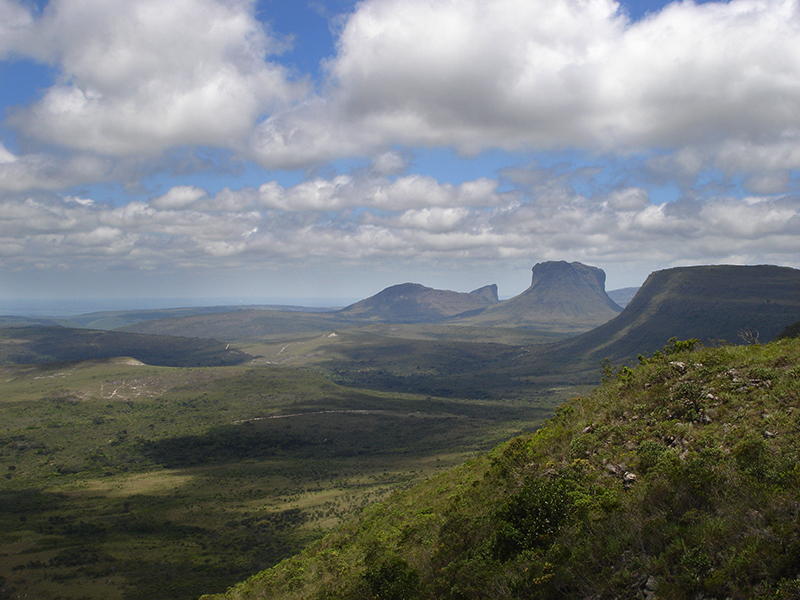 The national park area of Chapada Diamantina is a 1500 sq.km. area of mountainous country with an abundance of waterfalls, large caves, endemic flora and fauna and some lovely walks. The area is only accessible through a local town called Lencois which was just gorgeous. A small town, whose whole business is supporting tours, trips and people who go into the Chapada. The town is all single storey, narrow buildings which are home to a large mixed-race population. These homes are interspersed with restaurants, general food stores, bars and tour operators. The restaurants we ate at were good and well priced and delightfully sold white Chilean Sauvignon Blanc – Debbie could have a glass at last. The blot on the visit was the Pousada that we were lodged at, probably the cheapest and the worst in town judging by the fact that we were the only visitors stupid enough to stay there. Apparently, the only room available was a garret just under a roof that boiled during the day and managed to retain its heat during the night. The room was so hot and without air-conditioning that we were prepared to sleep with the windows and doors open, offering our soft, white bodies to all passing mosquitoes. Fortunately, they would rather remain in the cooler outside air than venture into our oven.
The national park area of Chapada Diamantina is a 1500 sq.km. area of mountainous country with an abundance of waterfalls, large caves, endemic flora and fauna and some lovely walks. The area is only accessible through a local town called Lencois which was just gorgeous. A small town, whose whole business is supporting tours, trips and people who go into the Chapada. The town is all single storey, narrow buildings which are home to a large mixed-race population. These homes are interspersed with restaurants, general food stores, bars and tour operators. The restaurants we ate at were good and well priced and delightfully sold white Chilean Sauvignon Blanc – Debbie could have a glass at last. The blot on the visit was the Pousada that we were lodged at, probably the cheapest and the worst in town judging by the fact that we were the only visitors stupid enough to stay there. Apparently, the only room available was a garret just under a roof that boiled during the day and managed to retain its heat during the night. The room was so hot and without air-conditioning that we were prepared to sleep with the windows and doors open, offering our soft, white bodies to all passing mosquitoes. Fortunately, they would rather remain in the cooler outside air than venture into our oven.
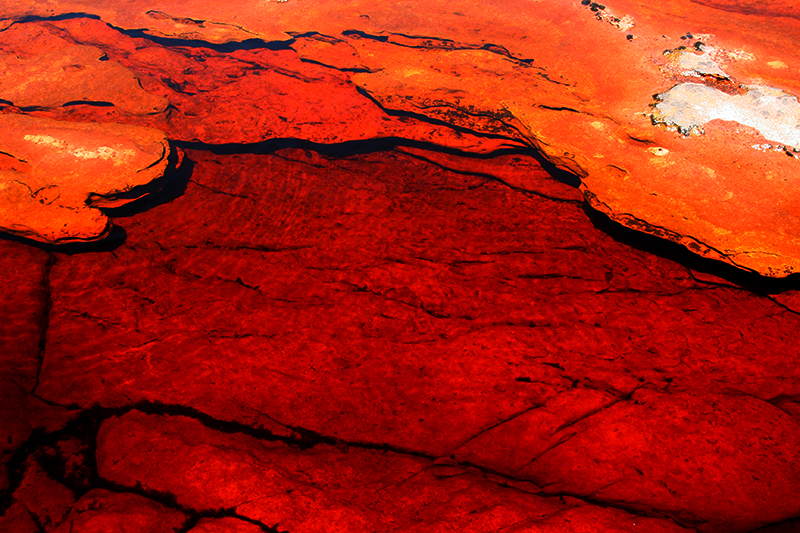 The rivers that flow through the area are similar to those of southern Venezuela in that the waters are bronzed by iron and tannins. The terrain too is one of flat top mountains created millions of years ago before any form of life existed. It is peculiar that such similar landscapes are over 2,000 miles apart, separated by the mighty Amazon and thick jungle.
The rivers that flow through the area are similar to those of southern Venezuela in that the waters are bronzed by iron and tannins. The terrain too is one of flat top mountains created millions of years ago before any form of life existed. It is peculiar that such similar landscapes are over 2,000 miles apart, separated by the mighty Amazon and thick jungle.
Our full day began with a visit to a waterfall called Poco do Diablo where the blood red Rio Mucugezinho plunges into a series of natural pools in which we spent some time swimming and cooling down.
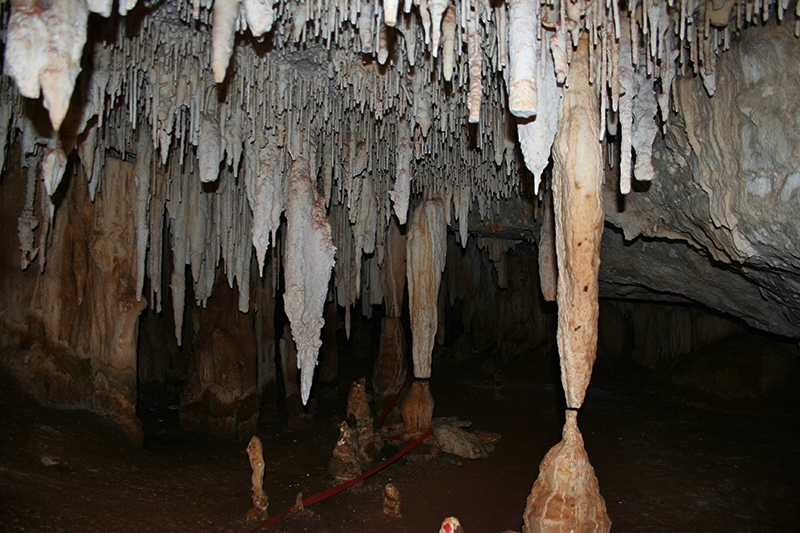 We climbed down deep into a dry cave, Fumacinha Gruta (Gruta = cave) trying hard not to knock off too many stalactites that reached down from the roof of the cave like a giant hairbrush. When we got to the end of the trail, deep in the earth, we entered a tiny area in which it was too low to stand and at this point the guide turned off his lamp, leaving us in a darkness that was complete. As if being tortured at night was not enough.
We climbed down deep into a dry cave, Fumacinha Gruta (Gruta = cave) trying hard not to knock off too many stalactites that reached down from the roof of the cave like a giant hairbrush. When we got to the end of the trail, deep in the earth, we entered a tiny area in which it was too low to stand and at this point the guide turned off his lamp, leaving us in a darkness that was complete. As if being tortured at night was not enough.
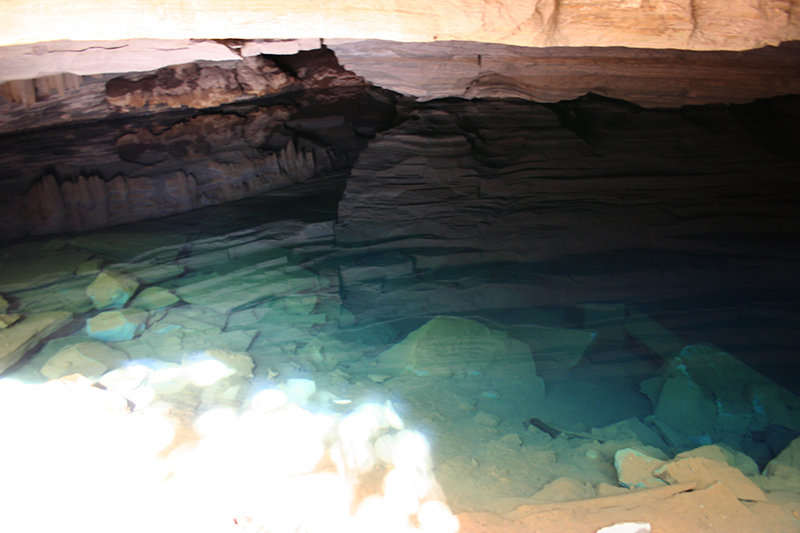 Next door was a different cave experience and this time, we had to wade through clouds of hungry mosquitoes that guard the entrance. Gruta Azul (Blue Cave), is so called because it has a pool of water that is crystal clear and a deep blue when the sun catches the surface. The water is so clear and clean that I would have walked straight into the water had I not been told it was there.
Next door was a different cave experience and this time, we had to wade through clouds of hungry mosquitoes that guard the entrance. Gruta Azul (Blue Cave), is so called because it has a pool of water that is crystal clear and a deep blue when the sun catches the surface. The water is so clear and clean that I would have walked straight into the water had I not been told it was there.
The final cave was called Gruta da Pratinha where we were clad in cold, wet buoyancy aids, masks and snorkels and sent into a long corridor that got black the further we swam into it. This time we had a torch so we could see but the water was very cold indeed and I began to think that the heat of our bedroom was really very acceptable. Nothing lived in the dark waters of the cave and the only sign of life was a terrapin that had obviously got lost.
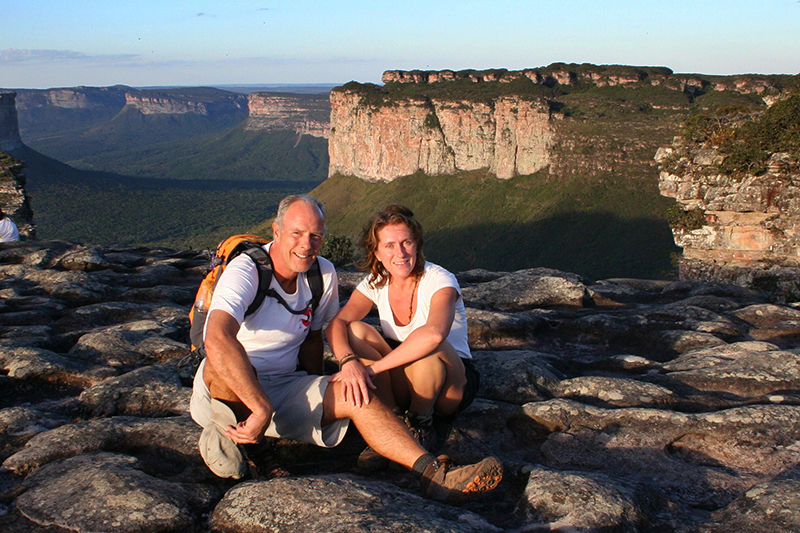 We finished our day sitting on top of Pai Inacio, a table top mountain that stands 1163m tall and has wonderful views of the surrounding Chapada as the sun dips below the horizon. We returned to the Pousada to warm up.
We finished our day sitting on top of Pai Inacio, a table top mountain that stands 1163m tall and has wonderful views of the surrounding Chapada as the sun dips below the horizon. We returned to the Pousada to warm up.
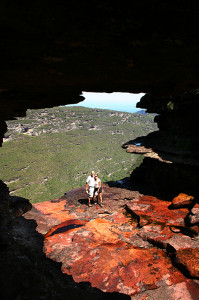 The next morning we were off for a hike to Cachoeira da Fumaca (the smoking waterfall). It is the second highest fall in Brazil after the Iguacu Falls and to get to it involves a 6km hike up one of the flat top mountains from the little village of Capao. It’s a hot slog during the middle of the day but, thankfully, there is intermittent cloud cover that provides some welcome shelter, the whole area having no tree cover whatsoever. It takes about 3 hours to get to the falls and we enjoy many fine views as we travel. The fall itself has a total drop of 420m with its longest uninterrupted fall of 380m. It gets the name ‘Smoking’ from the updraft of air currents that drives the water back up creating a smoke effect. I would like to report how wonderful, astonishing and marvelous this waterfall but I cannot because it was dry. The water that makes the fall is gathered by rain and precipitation from cloud that sits on top of the mountain for much of the time. This, however, was the dry season and the lack of rain had brought the spectacle to an end for the time being. A tiny trickle of red water spilt off the top of the mountain, crashed into some rocks about 40m from the top, whereupon it exploded into hundreds of small globules and evaporated long before it got halfway to the bottom.
The next morning we were off for a hike to Cachoeira da Fumaca (the smoking waterfall). It is the second highest fall in Brazil after the Iguacu Falls and to get to it involves a 6km hike up one of the flat top mountains from the little village of Capao. It’s a hot slog during the middle of the day but, thankfully, there is intermittent cloud cover that provides some welcome shelter, the whole area having no tree cover whatsoever. It takes about 3 hours to get to the falls and we enjoy many fine views as we travel. The fall itself has a total drop of 420m with its longest uninterrupted fall of 380m. It gets the name ‘Smoking’ from the updraft of air currents that drives the water back up creating a smoke effect. I would like to report how wonderful, astonishing and marvelous this waterfall but I cannot because it was dry. The water that makes the fall is gathered by rain and precipitation from cloud that sits on top of the mountain for much of the time. This, however, was the dry season and the lack of rain had brought the spectacle to an end for the time being. A tiny trickle of red water spilt off the top of the mountain, crashed into some rocks about 40m from the top, whereupon it exploded into hundreds of small globules and evaporated long before it got halfway to the bottom.
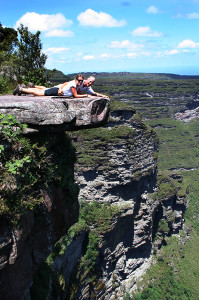 Nevertheless, we made the most of our time, walking along the slippery rock that made up the river bed to the edge of the precipice where the water would normally jump off. I have to say that we were too chicken to stand right on the edge of the fall but we were close enough to feel the strength of the updraft of the air current that showered drops of water over our heads. The volume of water that normally flows through has carved a huge funnel into the mountain rock that curves up high above our heads. It was an interesting experience to stand in the centre of where a river would spring off the top of a mountain, the water level some way above our heads, and try to imagine the volume and force of the current the moment before it leapt into space. How strong would the current feel? How long would it take before I hit the trees of the jungle 400m below? Could the updraft of air lift me to safety or would the weight of my sins be too great to save me? The answers were 10m/sec, 5 seconds and no chance!
Nevertheless, we made the most of our time, walking along the slippery rock that made up the river bed to the edge of the precipice where the water would normally jump off. I have to say that we were too chicken to stand right on the edge of the fall but we were close enough to feel the strength of the updraft of the air current that showered drops of water over our heads. The volume of water that normally flows through has carved a huge funnel into the mountain rock that curves up high above our heads. It was an interesting experience to stand in the centre of where a river would spring off the top of a mountain, the water level some way above our heads, and try to imagine the volume and force of the current the moment before it leapt into space. How strong would the current feel? How long would it take before I hit the trees of the jungle 400m below? Could the updraft of air lift me to safety or would the weight of my sins be too great to save me? The answers were 10m/sec, 5 seconds and no chance!

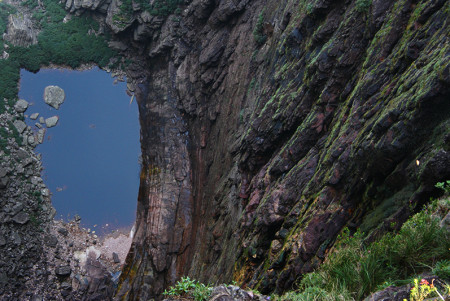
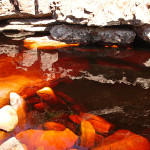
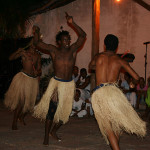
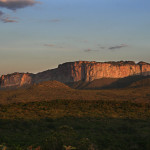
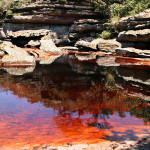
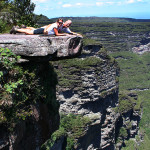
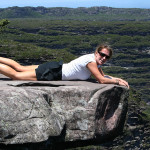
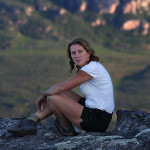
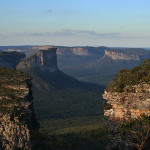
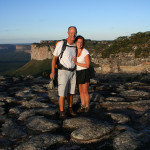
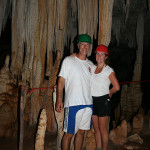
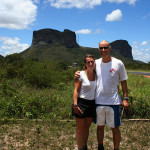
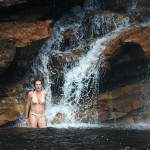
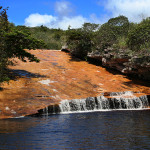

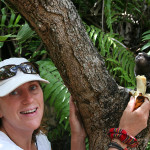
No comments yet.